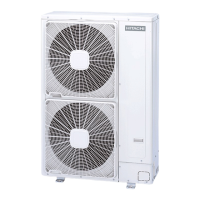8. Troubleshooting
253
SMGB0079 rev.0 - 01/2013
8
8.3 Troubleshooting in check mode
8.3.1 Troubleshooting using the remote controller PC-ART
Use the “OK” switch of the remote control in the following cases:
1 When the RUN LED is ickering.
2 To trace back the cause of the malfunction after restarting from the stoppa-
ge while the RUN LED is ickering.
3 To check during the normal operation or during the stoppage.
4 To monitor the inlet air temperature and the discharge air temperature.
Check mode
Check mode 2: The data which was held immediately before
the failure will be displayed
Check mode 1: Current data will be displayed
Normal mode
- The indication will delay as the transmission between the remote control switch and the
indoor unit takes about ten seconds.
- All the data may be displayed as "FF" or "1" or "255". These transient data, which
are produced temporarily by the software, do not affect the device functions at all. (The
alarm code may also be displayed as "FF".)
Unit number and
alarm code
displayed
The alarm code that identies the last fault that has occurred
in the displayed unit.
The unit number of the connected unit or the unit number for
which the checking mode was selected previously.
• ADDS: Number of the indoor unit in number ** cycle
• RN: Number ** refrigerant cycle
Check mode 1
After
seven
seconds
Within seven seconds to
check another unit
Forward:
Press the "" switch to increase from 00 to 01 to 02 ···
Backward:
Press the "" switch to decrease from 15 to 14 to 13 ···
Press "" to see the previous indication
Press "" to see the next indication
Press "" to see the next data
Press "" to see the previous data
Unit number and
alarm code
displayed
Check mode 2
(Refer to Check
mode 1 for details)
Check mode
disabled
Press ""
- In the check mode 2, the data of the rst three units
that are connected serially to a remote control switch
are available.
- You can press the “OK” switch to disable the check
mode 2. Check mode 1 cannot be disabled even if you
press the “OK” switch.
Press “OK”
for more than
3 seconds
After
seven
seconds
(A)
See (A)
Press “OK” for more than 3 seconds
Press “OK”
for more than
3 seconds

